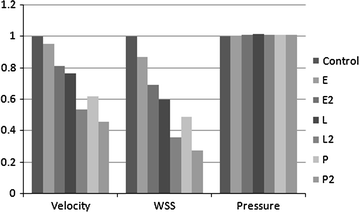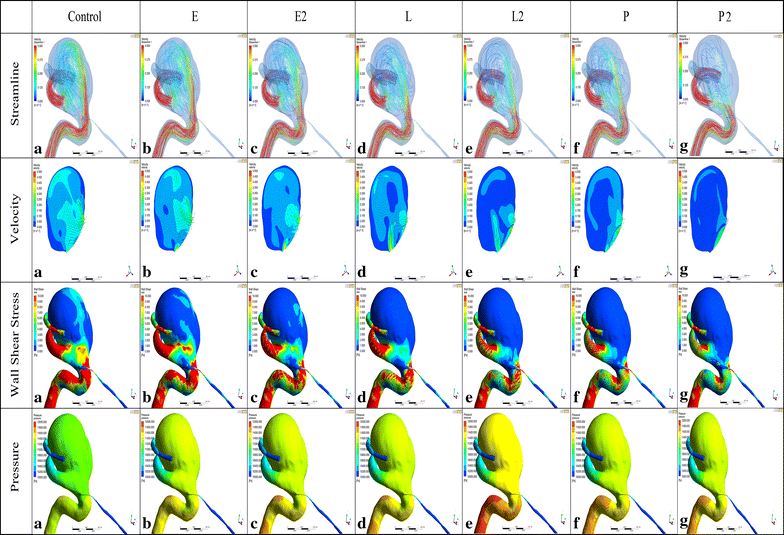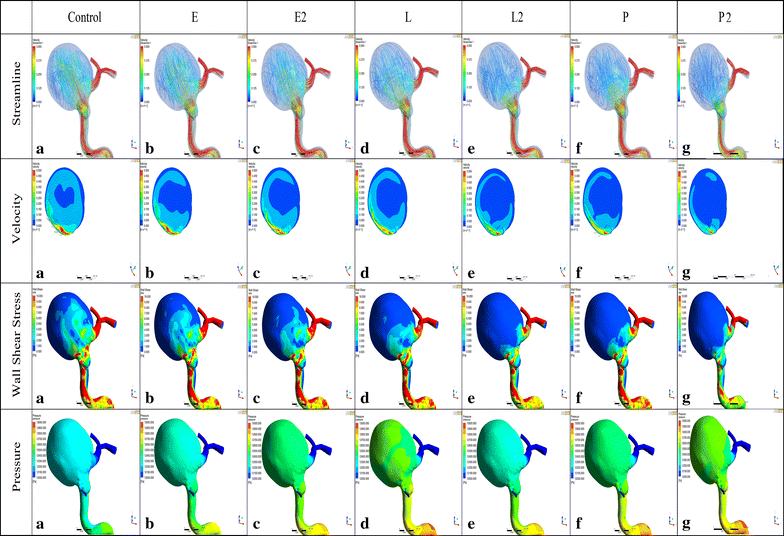Flow diverter effect of LVIS stent on cerebral aneurysm hemodynamics: a comparison with Enterprise stents and the Pipeline device
- PMID: 27370946
- PMCID: PMC4930570
- DOI: 10.1186/s12967-016-0959-9
Flow diverter effect of LVIS stent on cerebral aneurysm hemodynamics: a comparison with Enterprise stents and the Pipeline device
Abstract
Background: The aim of this study was to quantify the effect of the new Low-profile Visualized Intraluminal Support (LVIS®D) device and the difference of fluid diverting effect compared with the Pipeline device and the Enterprise stent using computational fluid dynamics (CFD).
Methods: In this research, we simulated three aneurysms constructed from 3D digital subtraction angiography (DSA). The Enterprise, LVIS and the Pipeline device were virtually conformed to fit into the vessel lumen and placed across the aneurysm orifice. Computational fluid dynamics analysis was performed to compare the hemodynamic differences such as WSS, Velocity and Pressure among these stents.
Results: Control referred to the unstented model, the percentage of hemodynamic changes were all compared to Control. A single LVIS stent caused more wall shear stress reduction than double Enterprise stents (39.96 vs. 30.51 %) and velocity (23.13 vs. 18.64 %). Significant reduction in wall shear stress (63.88 %) and velocity (46.05 %) was observed in the double-LVIS stents. A single Pipeline showed less reduction in WSS (51.08 %) and velocity (37.87 %) compared with double-LVIS stent. The double-Pipeline stents resulted in the most reduction in WSS (72.37 %) and velocity (54.26 %). Moreover, the pressure increased with minuscule extent after stenting, compared with the unstented model.
Conclusions: This is the first study analyzing flow modifications associated with LVIS stents. We found that the LVIS stent has certain hemodynamic effects on cerebral aneurysms: a single LVIS stent caused more flow reductions than the double-Enterprise stent but less than a Pipeline device. Nevertheless, the double-LVIS stent resulted in a better flow diverting effect than a Pipeline device.
Keywords: Computational fluid dynamics (CFD); Hemodynamics; Intracranial aneurysm; LVIS; Wall shear stress (WSS).
Figures






Similar articles
-
Hemodynamic differences between Pipeline and coil-adjunctive intracranial stents.J Neurointerv Surg. 2019 Sep;11(9):908-911. doi: 10.1136/neurintsurg-2018-014439. Epub 2019 Feb 27. J Neurointerv Surg. 2019. PMID: 30814328
-
Computational Study of Hemodynamic Changes Induced by Overlapping and Compacting of Stents and Flow Diverter in Cerebral Aneurysms.Front Neurol. 2021 Aug 2;12:705841. doi: 10.3389/fneur.2021.705841. eCollection 2021. Front Neurol. 2021. PMID: 34408723 Free PMC article.
-
Hemodynamic differences by increasing low profile visualized intraluminal support (LVIS) stent local compaction across intracranial aneurysm orifice.Interv Neuroradiol. 2020 Oct;26(5):557-565. doi: 10.1177/1591019920952903. Epub 2020 Aug 23. Interv Neuroradiol. 2020. PMID: 32830566 Free PMC article.
-
Alteration of intra-aneurysmal hemodynamics for flow diversion using enterprise and vision stents.World Neurosurg. 2010 Aug-Sep;74(2-3):306-15. doi: 10.1016/j.wneu.2010.05.008. World Neurosurg. 2010. PMID: 21197155 Free PMC article. Review.
-
Computational fluid dynamics (CFD) analysis in a ruptured vertebral artery dissecting aneurysm implanted by Pipeline when recurrent after LVIS-assisted coiling treatment: Case report and review of the literatures.Interv Neuroradiol. 2023 Aug;29(4):442-449. doi: 10.1177/15910199221097766. Epub 2022 Apr 28. Interv Neuroradiol. 2023. PMID: 35484808 Free PMC article. Review.
Cited by
-
Effects of stent-assisted coiling in comparison with flow diversion on intracranial aneurysms.Front Neurol. 2022 Nov 8;13:937536. doi: 10.3389/fneur.2022.937536. eCollection 2022. Front Neurol. 2022. PMID: 36425805 Free PMC article.
-
Venous outflow-targeted coil embolization of direct carotid-cavernous fistulas.Interv Neuroradiol. 2023 Jun;29(3):251-259. doi: 10.1177/15910199221084787. Epub 2022 Mar 3. Interv Neuroradiol. 2023. PMID: 35238235 Free PMC article.
-
Short- and Long-Term Safety and Efficacy of Self-Expandable Leo Stents Used Alone or with Coiling for Ruptured and Unruptured Intracranial Aneurysms: A Retrospective Observational Study.J Clin Med. 2021 Sep 30;10(19):4541. doi: 10.3390/jcm10194541. J Clin Med. 2021. PMID: 34640559 Free PMC article.
-
Additional Embolization for Intra-aneurysmal Blood Flow Resumption after Stent-assisted Embolization of Cerebral Aneurysms.J Neuroendovasc Ther. 2020;14(7):249-254. doi: 10.5797/jnet.oa.2019-0086. Epub 2020 Apr 22. J Neuroendovasc Ther. 2020. PMID: 37502618 Free PMC article.
-
Possibility of Worsening Flow Diversion Effect Due to Morphological Changes of a Stented Artery With Multiple Overlapping Stents for Partially Thrombosed Vertebral Artery Aneurysms.Front Neurol. 2020 Dec 15;11:611124. doi: 10.3389/fneur.2020.611124. eCollection 2020. Front Neurol. 2020. PMID: 33384657 Free PMC article.
References
Publication types
MeSH terms
Grants and funding
LinkOut - more resources
Full Text Sources
Other Literature Sources
Medical
Research Materials
Miscellaneous

